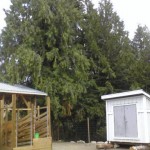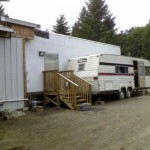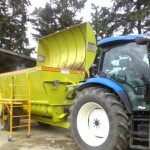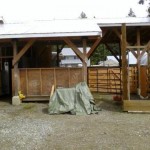A Different Sort of Slaughterhouse… a Look Inside Salt Spring Island’s New ‘Modular’ Abattoir
Posted: July 12, 2013
Categories: Food in the News / GoodFoodBites / The Meat Press
When the province of British Columbia passed a series of sweeping changes to the rules governing abattoirs and meat plants in 2004, the impacts on small abattoirs were severe and immediate, disrupting the production of and trade in locally-produced meat across the province.[i] Implemented in the name of improving the safety of BC’s food, the impacts of these changes were not exactly what BC’s government was expecting … and so they’ve spent the last 9 years trying to help the sector to recover (which has involved creating a couple of new categories for types of slaughter (D & E) – but that’s another story!)
Up until 2004 most abattoirs in the province were regulated by the municipal health authority but the new rules required that any plant processing animals be inspected and conform to an entirely new set of standards set by provincial agencies and enforced (at first – this is now being phased out) by the Canadian Food Inspection Agency (CFIA). This necessitated investments of hundreds of thousands of dollars for many, which was too much to bear for a huge number of small operations. And so the number of legal abattoirs operating across the province went from approximately 300 in 2003 to just 11 in 2004! (Now, they’re back up to about 60.)[ii]
For obvious reasons, the closing of so many abattoirs immediately altered the quality and quantity of locally-produced meat available, as producers either stopped raising livestock because they were left with nowhere to process it, or went ‘underground’ and processed their animals themselves or in uninspected plants. In many cases, the more rural and/or isolated communities suffered the most since all of the remaining plants were hundreds of miles away.
Salt Spring Island – the largest of the southern Gulf Islands, just off the coast from Victoria, and known for its vibrant farmers’ market, high quality lamb and gorgeous rolling coastlines – was no exception. Surveys of the island’s farmers between 2004 and 2008 indicated that 35% fewer people were farming after the new regulations were introduced, and that 50% less meat was being grown. These decreases are probably especially high because Salt Spring is an island; without a fully licenced abattoir on-island, farmers had to truck their animals onto the ferry and then further to an abattoir on Vancouver Island. This is not only an expensive and time-consuming process, but also a journey that is very stressful for the animals; many farmers were not willing to do it.[i]
So, faced with a community of small farms on rapid decline, a group of passionate island farmers and residents decided to take matters into their own hands. With the backing of two long-standing island farming organizations (the Island Natural Growers and the Salt Spring Island Farmers Institute, which had already joined forces to create the Salt Spring Island Agricultural Alliance) this new group decided that they’d build their own fully inspected, multi-species (red meat animals and poultry) abattoir.
On a sunny day earlier this month I found myself on the ferry headed towards Salt Spring to meet Margaret Thomson, one of the members of SSI Ag Alliance who has played a significant role in the development of the project. The island is even more beautiful than I’d anticipated, and as the ferry docked and I made my way onto the island bus I discovered that rumours of islanders’ hospitality were just as accurate. As fate would have it, I sat down next to another member of THE SSIAA – an organic grower herself for more than 25 years – and the fellow in front of us took it upon himself to make sure the bus driver knew precisely where to let me off. What service! Margaret was waiting at the end of the driveway and together we walked up to the abattoir, giant cedars towering above us…. this place would be a sure winner in a most-beautifully-located-abattoir contest!
The day-to-day operations of the abattoir are managed by a non-profit called the Salt Spring Abattoir Society which was created in June 2012, and Margaret is still deeply involved. The abattoir had its first slaughter day in September 2012 and now, after having been processing for 8 months (with a couple months off in mid-winter), they’ve already made huge progress in terms of efficiency. At first, slaughtering 8 lambs in a day was a challenge and now they can do 15-20 without much trouble. Right now they are only processing poultry and lamb, since a few hitches need to be worked out before they can take on the larger, more complicated process of cattle slaughter. The abattoir employs about 6 people part-time and slaughters 2-3 days each week.
One of the unique features of this facility is that it’s a modular abattoir, which is sort of half-way between a mobile abattoir (a fully moveable abattoir-on-a-trailer) and a regular, stationary abattoir. In this case, it means that part of the facility is on wheels (a 34 x 8 ft trailer) while the rest is more permanent, housed in pre-fabricated components. This means that if it were necessary, the abattoir could move and set up shop elsewhere – which is convenient since the land where it’s currently located is leased. In fact, originally the group thought the abattoir might operate as a mobile abattoir, potentially setting up on other Gulf Islands that lack their own abattoirs. But as the realities of ferry travel with very large trucks began to sink in, and no other Gulf Island jumped at the opportunity, this idea was scrapped.
The facility itself was not cheap, but it was custom built and can be used to process many different animals – which makes it more complex and expensive than, say, a poultry-only mobile abattoir. The mobile portion was built by a trailer company, modelled after a unit designed for bison slaughter, and was integrated into a custom-made design that was based on plans available from the BC government. The estimated cost was $350,000 but in reality it has taken over $450,000 to date and is still not quite done. Impressively, to round out a $150,000 government grant, much of this funding has come directly from residents of the island, as well as through donations from businesses and foundations. They have almost fully funded the construction and are now trying to raise the last 20% — this time looking to passionate foodies worldwide. They’ve recently launched a neat crowd-sourcing campaign; check it out here!
The process has been long and not always easy, but this committed crew hasn’t stopped – and along the way, they’ve learned a tremendous amount about what technologies and tools work the best in this kind of semi-mobile, multi-species facility. For instance, they found their on-demand propane hot water heating system to be quite a pain in the cooler months, as it had to be drained each night. Using huge containers with small holes to hold waste has worked very well – and have saved the septic system, which ought to only take liquids. And the mobile portion of the unit has made it hard to slaughter cattle because the lip of the truck prevents the winch (used to lift the animal from the kill floor and into the truck) from reaching out and over the floor fully. (Due to lambs’ smaller size, workers can manage to get them up without a winch that extends fully.) There are so many issues that can’t be predicted and tricky barriers to overcome… but this makes for a whole lot of valuable lessons that, if taken into consideration by those undetaking similar projects, could make the process both smoother and less costly!
Another amazing aspect of this project is the composting system that’s been set up as a partnership between the abattoir and a local farm. The offal (all the inedible bits of an animal) gets picked up soon after slaughter by a local farmer, who takes it back to his farm and composts it in an industrial feed wagon, complete with augers powered by a tractor. Everything left over from processing – including hides, bones, etc – except for SRM (specified risk materials like the spinal cords of older cattle, the parts that can carry disease) may be safety composted in this way. He just adds a few bales of hay and leaves the mixture turning for several half-hour stints each day. Within as few as 6 days the mix has been transformed into a beautiful, dark compost that is an excellent source of fertility for his crops! I can personally attest to the incredible heat that’s produced through the decomposition process … when we stopped by to see the composter in action I could hardly stand to keep my hand directly above the dark churning soil mix because of the hot steam rising from it! This system really ‘closes the loop’, transforming waste from the abattoir into a valuable product that this farmer would otherwise have to purchase. Talk about a mutually-beneficial exchange!
After a delicious lunch and visit to Margaret’s lamb and turkey farm I took the ferry back to Victoria, full of hope and mind churning with loads of new ideas. Although Margaret and her colleagues are still working on perfecting this new facility, they have already accomplished an incredible feat, the scope of which I can only begin to grasp. They have navigated the extremely murky waters of government regulation, creating space for a new kind of abattoir that works perfectly well but isn’t what we’re used to. They’ve also mobilized their community, running fundraisers and workshops of all kinds. Island residents really seem to be behind the abattoir, respecting the role it plays as a key piece of community infrastructure. Other communities, unfortunately, can only dream of having this much community support – in fact, a community just a few hours from the island has experienced huge opposition to the presence of an abattoir in their region.
Despite the difficulty of building a new kind of facility, this determined group has built a functional unit that is allowing small scale farming in their community to survive. The modular design did cost more than estimated, but it offers advantages and cost much less than most new permanent abattoirs do (for example, a new provincially inspected abattoir built in Rainy River (Northern Ontario) had a price tag of $1.9 million 4 years ago.)[iv] As this type of design gets refined, perhaps this type of small abattoir could be more easily replicated – and at progressively lower costs, as we figure out how to design and build them more efficiently.
As communities take on more projects like these – creating infrastructure that meets their particular needs, at a scale that makes sense – we all learn more about what it takes to create real, regionally-focused food systems. Kudos to the team on Salt Spring for having taken on this ambitious and important project.
Special thanks to Margaret for generously showing me around & answering my many questions!
[iv] Revell, Peggy. February 2, 2010. “District Abattoir Officially Opens.” http://www.rainyriverrecord.com/node/8771
3 responses to “A Different Sort of Slaughterhouse… a Look Inside Salt Spring Island’s New ‘Modular’ Abattoir”
Leave a Reply
You must be logged in to post a comment.





pure evil.
Greed! death and suffering
disgusting. humans are appalling.